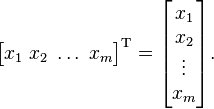Row vector
In linear algebra, a row vector or row matrix is a 1 × m matrix, i.e. a matrix consisting of a single row of m elements:[1]
The transpose of a row vector is a column vector:
The set of all row vectors forms a vector space (row space) which acts like the dual space to the set of all column vectors (see row and column spaces), in the sense that any linear functional on the space of column vectors (i.e. any element of the dual space) can be represented uniquely as a dot product with a specific row vector.
Notation
Row vectors are sometimes written using the following non-standard notation:
Operations
- Matrix multiplication involves the action of multiplying each row vector of one matrix by each column vector of another matrix.
- The dot product of two vectors a and b is equivalent to multiplying the row vector representation of a by the column vector representation of b:
Preferred input vectors for matrix transformations
Frequently a row vector presents itself for an operation within n-space expressed by an n by n matrix M:
- v M = p.
Then p is also a row vector and may present to another n by n matrix Q:
- p Q = t.
Conveniently, one can write t = p Q = v MQ telling us that the matrix product transformation MQ can take v directly to t. Continuing with row vectors, matrix transformations further reconfiguring n-space can be applied to the right of previous outputs.
In contrast, when a column vector is transformed to become another column under an n by n matrix action, the operation occurs to the left:
- p = M v and t = Q p ,
leading to the algebraic expression QM v for the composed output from v input. The matrix transformations mount up to the left in this use of a column vector for input to matrix transformation. The natural bias to read left-to-right, as subsequent transformations are applied in linear algebra, stands against column vector inputs.
Nevertheless, using the transpose operation these differences between inputs of a row or column nature are resolved by an antihomomorphism between the groups arising on the two sides. The technical construction uses the dual space associated with a vector space to develop the transpose of a linear map.
For an instance where this row vector input convention has been used to good effect see Raiz Usmani,[2] where on page 106 the convention allows the statement "The product mapping ST of U into W [is given] by:
 ."
."
(The Greek letters represent row vectors).
Ludwik Silberstein used row vectors for spacetime events; he applied Lorentz transformation matrices on the right in his Theory of Relativity in 1914 (see page 143). In 1963 when McGraw-Hill published Differential Geometry by Heinrich Guggenheimer of the University of Minnesota, he uses the row vector convention in chapter 5, "Introduction to transformation groups" (eqs. 7a,9b and 12 to 15). When H. S. M. Coxeter reviewed[3] Linear Geometry by Rafael Artzy, he wrote, "[Artzy] is to be congratulated on his choice of the 'left-to-right' convention, which enables him to regard a point as a row matrix instead of the clumsy column that many authors prefer."
See also
Notes
- ↑ Meyer (2000), p. 8
- ↑ Raiz A. Usmani (1987) Applied Linear Algebra Marcel Dekker ISBN 0824776224. See Chapter 4: "Linear Transformations"
- ↑ Coxeter Review of Linear Geometry from Mathematical Reviews
References
- Axler, Sheldon Jay (1997), Linear Algebra Done Right (2nd ed.), Springer-Verlag, ISBN 0-387-98259-0
- Lay, David C. (August 22, 2005), Linear Algebra and Its Applications (3rd ed.), Addison Wesley, ISBN 978-0-321-28713-7
- Meyer, Carl D. (February 15, 2001), Matrix Analysis and Applied Linear Algebra, Society for Industrial and Applied Mathematics (SIAM), ISBN 978-0-89871-454-8
- Poole, David (2006), Linear Algebra: A Modern Introduction (2nd ed.), Brooks/Cole, ISBN 0-534-99845-3
- Anton, Howard (2005), Elementary Linear Algebra (Applications Version) (9th ed.), Wiley International
- Leon, Steven J. (2006), Linear Algebra With Applications (7th ed.), Pearson Prentice Hall



